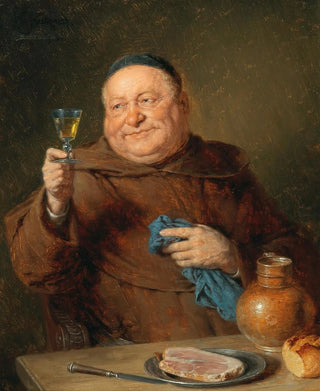Art print | The Monks' Meal - Eduard von Grützner


View from behind

Frame (optional)
Art print Le repas des moines - Eduard von Grützner – Engaging introduction
In the rich and complex universe of art history, certain works stand out for their ability to capture moments of life imbued with simplicity and depth. "Le repas des moines" by Eduard von Grützner is one of those pieces that, through its charm and atmosphere, invites the viewer to immerse themselves in a world where conviviality and spirituality meet. This scene, where monks gather around a table, evokes not only monastic culture but also a reflection on community and sharing. The art print of this work brings a touch of serenity and contemplation to our living spaces, while paying homage to the artist and his era.
Style and uniqueness of the work
Eduard von Grützner, master of genre painting, deploys in "Le repas des moines" a palette of warm colors and meticulous details that bring each character to life. The composition is skillfully orchestrated, with each monk occupying a specific place, contributing to the harmony of the scene. The faces are filled with expressiveness that tells stories, laughter, and silent exchanges. The play of light accentuates the textures of the robes and the delicious dishes adorning the table, creating an atmosphere that is both intimate and lively. The way Grützner captures the essence of monastic life, between reflection and joy, makes this work a true masterpiece, where each gaze reveals a new facet of the scene.
The artist and his influence
Eduard von Grützner, born in 1846, is an artist who established himself through his talent for depicting scenes of daily life, often inspired by monastic culture. His work is characterized by a particular attention to detail and an ability to convey emotions through his characters. Influenced by the realism movement, Grützner managed to combine tradition and innovation, making his paintings vivid testimonies of his time. His unique vision of monastic life left a mark on his contemporaries and continues to inspire artists today. In rediscovering "Le repas des moines," one cannot help but

Matte finish

View from behind

Frame (optional)
Art print Le repas des moines - Eduard von Grützner – Engaging introduction
In the rich and complex universe of art history, certain works stand out for their ability to capture moments of life imbued with simplicity and depth. "Le repas des moines" by Eduard von Grützner is one of those pieces that, through its charm and atmosphere, invites the viewer to immerse themselves in a world where conviviality and spirituality meet. This scene, where monks gather around a table, evokes not only monastic culture but also a reflection on community and sharing. The art print of this work brings a touch of serenity and contemplation to our living spaces, while paying homage to the artist and his era.
Style and uniqueness of the work
Eduard von Grützner, master of genre painting, deploys in "Le repas des moines" a palette of warm colors and meticulous details that bring each character to life. The composition is skillfully orchestrated, with each monk occupying a specific place, contributing to the harmony of the scene. The faces are filled with expressiveness that tells stories, laughter, and silent exchanges. The play of light accentuates the textures of the robes and the delicious dishes adorning the table, creating an atmosphere that is both intimate and lively. The way Grützner captures the essence of monastic life, between reflection and joy, makes this work a true masterpiece, where each gaze reveals a new facet of the scene.
The artist and his influence
Eduard von Grützner, born in 1846, is an artist who established himself through his talent for depicting scenes of daily life, often inspired by monastic culture. His work is characterized by a particular attention to detail and an ability to convey emotions through his characters. Influenced by the realism movement, Grützner managed to combine tradition and innovation, making his paintings vivid testimonies of his time. His unique vision of monastic life left a mark on his contemporaries and continues to inspire artists today. In rediscovering "Le repas des moines," one cannot help but






